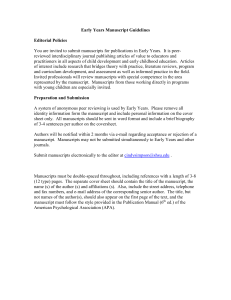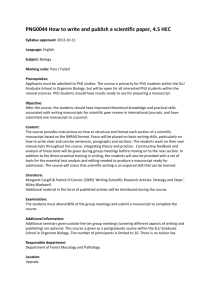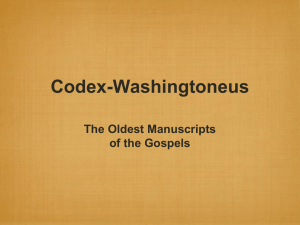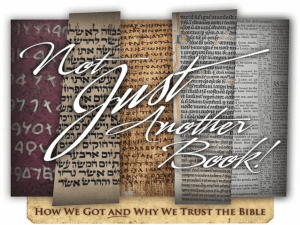The King James Bible – Preserved From Satan`s Attack
advertisement
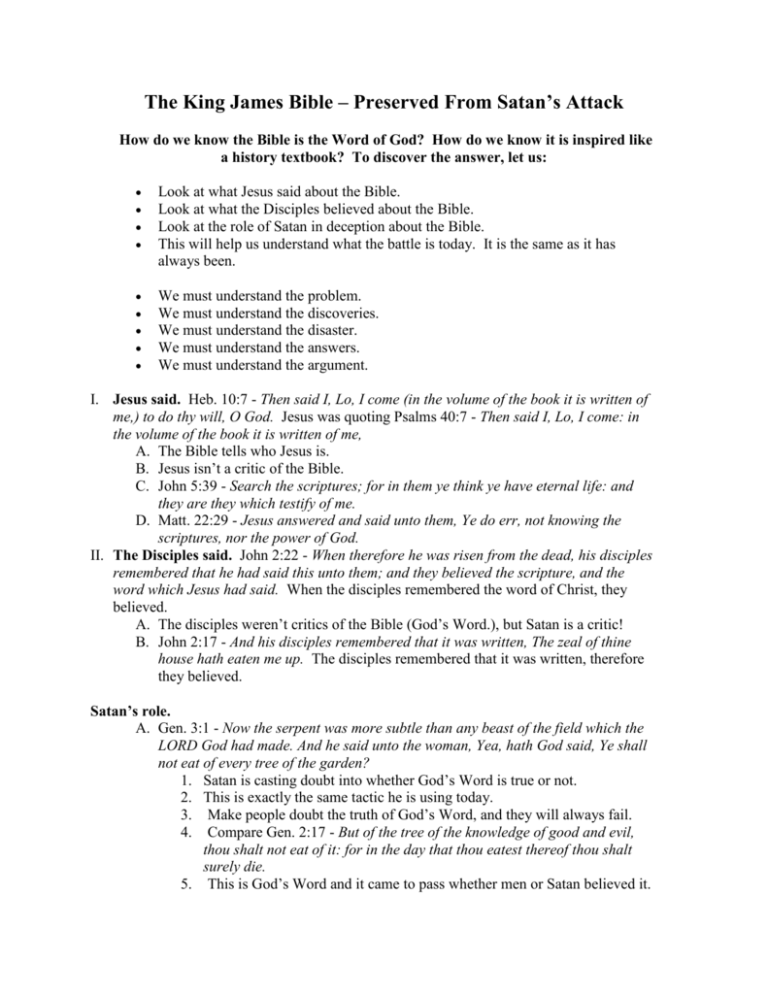
The King James Bible – Preserved From Satan’s Attack
How do we know the Bible is the Word of God? How do we know it is inspired like
a history textbook? To discover the answer, let us:
Look at what Jesus said about the Bible.
Look at what the Disciples believed about the Bible.
Look at the role of Satan in deception about the Bible.
This will help us understand what the battle is today. It is the same as it has
always been.
We must understand the problem.
We must understand the discoveries.
We must understand the disaster.
We must understand the answers.
We must understand the argument.
I. Jesus said. Heb. 10:7 - Then said I, Lo, I come (in the volume of the book it is written of
me,) to do thy will, O God. Jesus was quoting Psalms 40:7 - Then said I, Lo, I come: in
the volume of the book it is written of me,
A. The Bible tells who Jesus is.
B. Jesus isn’t a critic of the Bible.
C. John 5:39 - Search the scriptures; for in them ye think ye have eternal life: and
they are they which testify of me.
D. Matt. 22:29 - Jesus answered and said unto them, Ye do err, not knowing the
scriptures, nor the power of God.
II. The Disciples said. John 2:22 - When therefore he was risen from the dead, his disciples
remembered that he had said this unto them; and they believed the scripture, and the
word which Jesus had said. When the disciples remembered the word of Christ, they
believed.
A. The disciples weren’t critics of the Bible (God’s Word.), but Satan is a critic!
B. John 2:17 - And his disciples remembered that it was written, The zeal of thine
house hath eaten me up. The disciples remembered that it was written, therefore
they believed.
Satan’s role.
A. Gen. 3:1 - Now the serpent was more subtle than any beast of the field which the
LORD God had made. And he said unto the woman, Yea, hath God said, Ye shall
not eat of every tree of the garden?
1. Satan is casting doubt into whether God’s Word is true or not.
2. This is exactly the same tactic he is using today.
3. Make people doubt the truth of God’s Word, and they will always fail.
4. Compare Gen. 2:17 - But of the tree of the knowledge of good and evil,
thou shalt not eat of it: for in the day that thou eatest thereof thou shalt
surely die.
5. This is God’s Word and it came to pass whether men or Satan believed it.
6.
Gen. 2:4 - And the serpent said unto the woman, Ye shall not surely die:
a. Satan lied.
b. Adam and Eve died, just like God’s Word said.
B. Satan hates God’s Word and is attacking it today like never before.
1. Satan’s attack is a humanistic attack.
2. Rom. 3:2-4 - Much every way: chiefly, because that unto them were
committed the oracles of God. 3 For what if some did not believe? shall
their unbelief make the faith of God without effect? 4 God forbid: yea, let
God be true, but every man a liar; as it is written, That thou mightest be
justified in thy sayings, and mightest overcome when thou art judged.
3. Paul is not a critic of the Bible.
4. God is faithful regardless of who believes.
5. “It is written” refers to a combination of scripture (not any one particular
scripture) that points out that Satan and men are liars but the Word of God
can be trusted for the truth.
a. Ps. 119:160 - Thy word is true from the beginning: and every one
of thy righteous judgments endureth for ever.
b. Ps. 138:2 - I will worship toward thy holy temple, and praise thy
name for thy lovingkindness and for thy truth: for thou hast
magnified thy word above all thy name.
c. Ps. 62:9 - Surely men of low degree are vanity, and men of high
degree are a lie: to be laid in the balance, they are altogether
lighter than vanity.
d. Ps. 116:11 - I said in my haste, All men are liars.
6. To doubt the scriptures - people must use their human brain, not Godgiven spirit.
C. Two reasons we shouldn’t doubt God’s Word.
1. II Tim. 3:13-17 - But evil men and seducers shall wax worse and worse,
deceiving, and being deceived. 14 But continue thou in the things which
thou hast learned and hast been assured of, knowing of whom thou hast
learned them; 15 And that from a child thou hast known the holy
scriptures, which are able to make thee wise unto salvation through faith
which is in Christ Jesus. 16 All scripture is given by inspiration of God,
and is profitable for doctrine, for reproof, for correction, for instruction in
righteousness: 17 That the man of God may be perfect, thoroughly
furnished unto all good works.
a. The teaching of inspiration (God-breathed)
b. Men will deceive - we must continue in the Holy Scripture.
c. What did God breathe?
1) The words of the writings.
2) We are talking about verbal inspiration.
3) The Bible contains the very words of God.
4) We are not talking about a process or a person (like the
Church of Christ believe).
5) He breathed WORDS.
2. God protected the words He breathed.
a.
Ps. 119:89,90 - For ever, O LORD, thy word is settled in heaven.
90 Thy faithfulness is unto all generations: thou hast established
the earth, and it abideth.
b. Matt. 24:35 - Heaven and earth shall pass away, but my words
shall not pass away.
c. Matt. 5:17,18 - Think not that I am come to destroy the law, or the
prophets: I am not come to destroy, but to fulfil. 18 For verily I
say unto you, Till heaven and earth pass, one jot or one tittle shall
in no wise pass from the law, till all be fulfilled.
1) In heaven, the Words of God are sure, steadfast and
forever.
2) On earth, the Words of God shall never pass away.
3) The jot is the smallest letter.
4) The tittle is the smallest part of the smallest letter.
3. The two above points are the DOCTRINE OF PRESERVATION.
a. Original inspiration.
b. Continuous preservation.
What the Battle is - Which Bible shall we use?
A. On one side - all translation except the King James Version.
B. On the other side - 110 translations.
1. We can’t study all these “Bibles” to find out which one is the right
version.
2. It’s not so much the translation as it is the SOURCE of the translation.
C. Question:
1. Can God use imperfect man to write a perfect book?
a. YES.
b. There is such a thing as Original Inspiration.
2. Can God use imperfect man to copy a perfect copy?
a. YES.
b. There is such a thing as Continual Preservation.
V. There are only two sources.
A. The King James Version is from one source.
B. All the other translations come from a different source.
1. All translations have come about in the last 100 years.
2. Textual critics (modern “scholars”) have forced us into this dilemma.
a. This dilemma wasn’t faced 100 years ago.
b. There is a host of new translations, and new ones every year.
c. What is to be done with all these new translations.
3.
There are two different approaches to the Bible.
King James Version
Given by God and people who believe
in verbal inspiration and preservation.
God is true and all men are liars.
Others
Given by people who don’t believe in
verbal inspiration.
Man’s mind can be used to criticize
and correct God’s Word.
Believe in Satan’s attack against the
Bible.
Don’t like to mention Satan’s attack
because it is not scientific.
VI. Why should we use the authorized version?
A. The Old Testament is written in Hebrew and the New Testament is written in
Greek.
1. There is basic agreement in the Hebrew manuscripts.
2. There is no basic agreement in the Greek manuscripts.
B. A manuscript is a handwritten document (before the days of the printing press).
1. Man-u-script.
2. Script written by the hand of man.
VII. Controversy of Greek manuscripts.
A. For a graphic representative of this subject, see Graphic # 1.
B. Byzantine Type Text. See Graphic # 2
1. These text came from the Christian school located at Antioch, Syria.
2. These texts were preserved by the Byzantine empire which held power
about 330-1453 A.D.
3. Thousands of copies were made from these texts.
4. It is called the “traditional Text”.
C. Alexandrian Text Type. See Graphic # 3
1. From the liberal Christian school in Alexandria, Egypt.
2. They are famous for using the pagan Greek philosophers to understand
the Bible
3. Alexandria is not a reputable place as far as truth is concerned.
4. See Acts 6:9 for an example of the Alexandrian sect persecuting Stephen.
5. See Acts 18:24 for an example of the ignorance that came out of the
“Christian school” at Alexandria.
VIII. What the “Textual Critics” use to decide which is the better text.
A. The difficult reading is better than the easy reading.
1. A difficult reading is what happens when the particular scripture is hard
to understand or there appears to be a contradiction.
2. If it appears there is a mistake in the scripture, that mistake makes that
scripture “true.”
3. The textual critics would assume the writer was mistaken, because he is a
sinner and couldn’t help it.
4. Mark 1:2 is an example.
a. Isaiah 40:10 - The voice of him that crieth in the wilderness,
Prepare ye the way of the LORD, make straight in the desert a
highway for our God.
b. Malachi 3:1 - Behold, I will send my messenger, and he shall
prepare the way before me:…
5. See how they don’t believe in inspiration, or preservation?
B. The shorter reading is better than the longer reading.
1.
Mark 16 is better short than long. Only verses 1-8 are included in the
modern versions.
2. They don’t believe in preservation.
3. They should have assumed somebody didn’t copy it all, therefore the
longer reading would be better.
C. The earlier dated manuscripts are better than the later dated manuscripts.
1. What if an earlier manuscript was set aside because of mistakes and
couldn’t be trusted?
2. Older is not necessarily better.
3. This thought is very unbelievable at first glance.
4. We are in the habit of thinking that something older is necessarily better.
IX. Why isn’t the Byzantine Text Type the oldest?
A. The Byzantine manuscripts were much more reliable, therefore were used more.
1. More and more copies were made of them.
2. These copies were worn out and disappeared.
B. The Alexandrian manuscripts weren’t as reliable, therefore were set aside by the
majority of people and remained in a “like-new” condition.
C. The Traditional Text (Byzantine Text).
1. It is easier to read (because of original inspiration and continual
preservation).
2. It is longer (because all the words were included).
3. They were worn out and disappeared because they were used so much.
4. This made the traditional text (copies) to be dated later.
D. The textual critics say the Traditional Text is inferior because:
1. It doesn’t have the more difficult reading.
2. It doesn’t have the shorter reading.
3. It is dated later rather than earlier.
X. History of the English Bible. (Why was it necessary to have a new Bible from new
sources?)
A. The argument from the revisionists viewpoint.1 [2]
1. The Revised Standard Version is a revision of the American Standard
Version, published in 1901, which was a revision of the King James
Version of 1611.2 [3] (WWR - The “scholars” would think, after all of this,
surely an updated version would be necessary. See Appendix A.)
AppendixA
2. “…the King James Version has grave defects. By the middle of the
nineteenth century, the development of biblical studies and the discovery
of many manuscripts more ancient than those upon which the King James
Version was based, made it manifest that these defects are so many and so
serious as to call for revision of the English translation. …”3 [4]
“The King James Version of the New Testament was based upon a Greek
text that was marred by mistakes, containing the accumulated errors of
fourteen centuries of manuscript copying.”4 [5] (WWR - I believe God
preserved His Word through all these centuries, and didn’t need men to
tamper with it to keep it pure.)
4. “A major reason for revision of the King James Version … is the change
since 1611 in English usage. (WWR - There is a failure of these
“scholars” to mention that the King James Version has been revised at
least 5 times since 1611. The version we use today is the 1867 revision.)
Many forms of expression have become archaic … the use of thou, thee,
thy, thine and the verb endings -est and -edst, and the verb endings -eth
and -th. … The greatest problem, however, is presented by the English
words which are still in constant use but now convey a different meaning
from that which they had in 1611 and in the King James Version. The
King James Version uses the word “let” in the send of “hinder,” “prevent”
to mean “precede,” “allow” in the sense of “approve,” “communicate” for
“share,” “conversation” for conduct,” “comprehend” for “overcome,”
“ghost” for “spirit,” “wealth” for “well-being,” “allege” for “prove,”
“demand” for “ask,” “take no thought” for “be not anxious,” “purchase a
good degree” for “gain a good standing,” etc.5 [6] (WWR - There is no
doubt in my mind that some of these words could be undated with no harm
to the King James Version, but there is no sense in “throwing out the baby
with the bath water!”)
B. The real reasons men wanted to revise, then replace the King James Version.
Many discoveries were made in the 1800’s, which was a time of great learning. A
time of “ever learning and never able to come to the knowledge of the truth.” II
Tim. 3:7
1. In religion, the “new science” of evolution by Charles Darwin (18021882).
a. 1858 first introduced thoughts of Origin of Species.
b. 1859 - Origin of Species.
2. In politics, Communism by Karl Marx (1818-1883).
a. Communists Manifesto - 1848
b. Revolutionary new economic, social, government plan.
3. In psychiatry, Sigmund Freud (1856-1939) - The Man and His Ego.
a. Freud’s first work was On Aphasia, published in 1891.
b. Freud is an Austrian physician, neurologist, and the founder of
psychoanalysis.
C.
The study of the Bible in all this.
3.
1.
People wanted new discoveries in this area because they had all these new
discoveries in other areas.
2. Many different people went to look for new, previously undiscovered
manuscripts.
3. They looked in old libraries, and in dark corners of libraries for old
books.
D. Somebody went to the 6th-century Monastery of Saint Catherine near Jabal Musa
on the Sinai Peninsula.
1. Some monks were throwing away some old manuscripts dated 350 A.D.
2. These old manuscripts were the Alexandrian Text Type - it hadn’t been
used.
3. The year was 1844.
4. The old manuscripts were called the Codex Sinaiticus (manuscripts from
Sinai).
5. Among the manuscripts called the Codex Sinaiticus, are some
manuscripts attributed to Barnabas.
a. The writings ascribed to Barnabas have been the source of dispute
among Biblical scholars.
b. The early Christian writer Tertullian assigns to him the authorship
of the Epistle to the Hebrews, in accordance with 2nd century
church tradition.
c. The apocryphal Acts of Barnabas, a work of late date, recounts his
missionary tours and his death by martyrdom in Cyprus.
d. The extant Epistle of Barnabas, found in a New Testament
manuscript (part of the Codex Sinaiticus in a monastery at Mount
Sinai), is a didactic (academic) work, full of allegorical
interpretations of the Old Testament and attacks on Judaism.
e. Although Barnabas was said to be its author by early Christian
writers, the epistle itself makes no such claim, and authorship by
him is held to be improbable.6 [7]
f. If Barnabas wrote the above mentioned books, it is an absolute
truth that they are not inspired of God, because Barnabas was not
an apostle (of the twelve). (See appendix B)
g. II Peter 3:2 - That ye may be mindful of the words which were
spoken before by the holy prophets, and of the commandment of us
the apostles of the Lord and Saviour:
h. Barnabas was not an apostle (of the twelve), therefore, according
to scripture, did not write any of the Scripture, even though he may
have written some good books. (See Appendix B)
i. The fact that these “scholars” accept the Codex Sinaiticus as the
Word of God, and attribute one of the manuscripts to Barnabas
ought to be proof enough they don’t know what God accepts as
Scripture.
j.
E.
F.
G.
H.
To be consistent, they should deny that II Peter 3:2 (therefore the
entire Bible) is inspired.
Somebody else went to the libraries in the Vatican in Rome, Italy.
1. In the late 1800’s, they found a manuscript the Romans had hidden.
2. This manuscript was called Codex Vaticanus after the Vatican.
3. It was an Alexandrian Text Type dated 350 A. D.
Now there is great excitement.
1. Scholars said there is a great need for a new Greek text based on the two
recent discoveries.
a. The Codex Sinaiticus - stored in the British Museum.
b. The Codex Vaticanus - Stored at the Vatican in Rome, Italy.
2. They will forget about the traditional text because they believe the two
recent discoveries plus the Codex Alexandrinus (stored in the British
Museum) makes the traditional text invalid.
A great disaster now occurred.
1. Published a brand-new Greek text called the Westcott-hort Greek Text.
2. Used a little Codex Vaticanus and a little Codex Sinaiticus, and a little
from someplace else.
3. This is called “ack-lectic” in the academic world.
4. It means to pick and choose.
The textual critics (called scholars by some) approved the new “ack-lectic” Greek
text, but continually criticized the traditional Greek Text which had been around
for 1500 years.
1.
God’s people rejected this Greek Text.
2. The textual critics immediately published two new English translations
based on the Westcott-hort Greek text. (See Appendix A) AppendixA
a. English Revised Version of 1881-1885 by the authority of the
Church of England. This text was primarily for the people of
England and U. S.
b. American Standard Version of 1901 by American scholars
associated in the work of the English Revised Version.
c. Neither of the above versions were widely accepted, but they were
changed so much in subsequent publications that in 1928, the
American Standard Version was copyrighted by the International
Council of Religious Education, so it couldn’t be changed.7 [8]
3. God’s people didn’t buy them.
4. But a change took place.
5. The National Council of Churches published the Revised Standard
Version (RSV - New Testament in 1946: Complete Bible in 1951 or
1952).
a. Representatives of 40 Protestant denominations in the U. S. and
Canada served on this committee.
b. There was an advisory board of 32 “scholars”.
c. 2/3 vote was required to make any changes.
d. Proverbs 11:21 - Though hand join in hand, the wicked shall not
be unpunished: but the seed of the righteous shall be delivered.
e. Widely accepted by Orthodox, Protestant, and Roman Catholic
Christians, it provided the basis for the first ecumenical English
Bible.8 [9] (If it is widely accepted by these unbelievers, it cannot
be good! WWR)
3. Phillips translation in 1958 by an evangelical. Some accepted this version
because of his being an evangelical.
4. American Standard Version of 1971.
5. The Living Bible of 1971.
6. Good News For Modern Man - 1971.
7. The New International Version - 1971.
I. In 1861, John Burgon wrote against the Westcott-Hort Greek Text.
1. One book was titled, “The Revision Revised” in which he showed that the
oldest texts were from Italy, Syria, and France, and these were what we
call the traditional texts.
2. He published another book called “Textual Corruption.”
3. He wrote another book titled, “Why We Ought To Keep The Traditional
Text” where he brought out many facts against the Westcott-Hort Greek
text and the Codex Alexandrinus, Codex Vaticanus and Codex Sinaiticus.
4. He won the argument, but his book was ignored.
XI. Conclusion.9 [10]
A. Facts that favor the traditional texts.
1. Of all the ancient Greek text (about 5,300), 95% belong to the traditional
group.
2. They all agree.
3. This fact strongly suggest God’s hand in preservation.
B. The traditional Greek texts go back as far as 400 A.D. It must be noted that the
northern weather is very hard on leather parchment which decayed.
C. Variety of evidences.
1. Used in North Africa.
2. Used all over Asia and Europe.
3. The Codex Alexandrinus is used only in Egypt.
D. Languages the traditional texts have been translated into.
1. Asia, Syria, Italian, France, England, Africa.
2. The Alexandrinus translation never translated into other languages.
E. Quotations from early church fathers.
1. 87,000 total.
2. The majority was from the traditional texts.
3.
The Traditional Text was accepted for at least 1500 years, probably closer
to 1900 years.
4. Never had any other Greek Text been received by Christianity.
5. Only in the 1900’s has this taken place.
6. Church readings (to be read in church services).
a. There are about 2,000 of these.
b. All of these are from the traditional text.
c. NONE from other translations.
F. The Sinai Manuscript.
1. This manuscript leaves 4,000 words out of the gospels.
2. This manuscript add about 1,000 words.
3. This manuscript changes the reading in about 1,500 places.
4. The National Council of Churches had three editors working on it
because it was so filled with errors.
5. This manuscript adds six new books to the Bible.
6. Deuteronomy 4:2 - Ye shall not add unto the word which I command you,
neither shall ye diminish ought from it, that ye may keep the
commandments of the LORD your God which I command you.
7. Revelation 22:18,19 - For I testify unto every man that heareth the words
of the prophecy of this book, If any man shall add unto these things, God
shall add unto him the plagues that are written in this book: 19 And if any
man shall take away from the words of the book of this prophecy, God
shall take away his part out of the book of life, and out of the holy city,
and from the things which are written in this book This is written about
the book of Revelation, but I sincerely believe God will do the same to
those who intentionally add, subtract, or alter His Word.
G. The Vatican Manuscript.
1. This manuscript left out 1,000 sentences.
2. This manuscript added about 500 words.
3. This manuscript changed words around some 2,000 times.
4. This manuscript disagreed with the Sinai manuscript some 600 times.
5. This manuscript leaves out 5 books of the New Testament.
6. This manuscript adds 5 different books that are not supposed to be there.
7. There Vatican Manuscript and the Sinai Manuscript disagree in some
17,000 places.
XII. A better view (See Graphic # 4)
The Purpose of truth - To Seek, To Know, To Stand.
Old Testament Hebrew Texts
The Greek Old Testament is known as the Septuagint. The name Septuagint means “70”
because the Old Testament was translated into Greek in the third century by 72 scholars
at Alexandria.
What is the “Textus Receptus”?10 [11]
Under the heading of Editions of the Greek Text, the author states that the Elzevir brothers
published at Leyden in 1633 an edition described in the title page as the “Received Text,”
the “Textus Receptus.” Among English readers this title has often been given to Robert
Stephen’s edition of 1550. It should be noted that Robert Stephens produced editions of
the Greek in 1546, 1549, 1550 and 1551.
Masoretic Texts11 [12]
With regard to the Old Testament, the chief distinction is between texts in Hebrew
and the versions, or translations into other ancient languages. The most important, and
generally most reliable, witnesses to the Hebrew are the Masoretic texts, those produced
by Jewish scholars (called the Masoretes) who assumed the task of faithfully copying and
transmitting the Bible (see Masora). These scholars, active from the early Christian
centuries into the Middle Ages, also provided the text with punctuation, vowel points (the
original of the Hebrew text contains only consonants), and various notes. The standard
printed Hebrew Bible in use today is a reproduction of a Masoretic text written in ad
1088. The manuscript, in codex or book form, is in the collection of the Saint Petersburg
Public Library. Another Masoretic manuscript, the Aleppo Codex from the first half of
the 10th century ad, is the basis for a new publication of the text in preparation at Hebrew
University in Israel. The Aleppo Codex is the oldest manuscript of the entire Hebrew
Bible, but it dates from well more than a millennium after the latest biblical books were
written, and perhaps as much as two millennia later than the earliest ones.
Appendix A
Versions of the English Bible
1.
King James Version of 1611. Revised approximately 5 times. The version we use today
is probably 1867.
2. English Revised Version of 1881-1885 (sometimes called the Revised Version). The
Church of England authorized this version using the King James Version, plus the Codex
Sinaiticus, Codex Vaticanus, and the Codex Alexandrinus, which “scholars” believed to
be more accurate than the King James. This version started out to be a replacement of the
King James Version, but eventually became a version in its own right. (WWR - It should
be noted that the decision to replace the King James Version was made after only 14-18
years {1881 and 1885 - 1867}. It is obvious that the English language had not changed
that much. The discoveries of supposedly more ancient Greek and Hebrew manuscripts
than that which the King James Version was based upon had not had time to filter into
the system.)
3.
American Standard Version of 1901. This text incorporates the reading preferred by the
American members of the Revision Committee of 1881-1885. (WWR - It seems this
version is a revision of the English Revised Version of 1881-1885.) This version was
supposed to replace the King James Version in the United States, but failed because the
people wouldn’t be duped by the so called experts at this time.
4. Revised Standard Version of 1952. This is an authorized revision of the American
Standard Version.
Appendix B
Barnabas is not an apostle (of the twelve)
An apostle is defined as “one sent forth”, or a messenger. There is more than one "type"
of apostle.
First: The apostles are generally referred to in Acts 1:15-26 as those men who (verse 17)
were numbered with Christ and had obtained part of his ministry, (verse 21) those men
who had companied with Christ and the other apostles during the entire ministry of Christ
and (verse 22), those men who were baptized with the baptism of John the Baptist. These
men are sometimes called the twelve, even when there were only eleven of them.
Apparently there were a total of fourteen men who filled these qualifications, because
before the Day of Pentecost there were only two names given, in addition to the names of
the apostles given in Matthew 10:2-4 and Luke 6:12-16.
Second: Acts 14:14 declares, Which when the apostles, Barnabas and Paul, heard of,
they rent their clothes, and ran in among the people, crying out. Barnabas is here
included with Paul as an apostle, because both are “sent forth with a message”. Their
sending is recorded in Acts 13:1-3. Acts 9:27, revealing how Barnabas brought the
newly converted Saul to the apostles, reflects a difference between the apostles who were
taught by Jesus Christ and those apostles who were sent forth with a message. But
Barnabas took him, and brought him to the apostles, and declared unto them how
he had seen the Lord in the way, and that he had spoken to him, and how he had
preached boldly at Damascus in the name of Jesus.
Paul declares his apostleship in Romans 1:1, 1:5, 11:13, I Corinthians 1:1, 4:9, 9:1 9:2,
15:9, II Corinthians 1:1, 11:5, 12:12, Galatians 1:1, 1:17, 2:8, Ephesians 1:1, Colossians
1:1, I Timothy 1:1, 2:7, II Timothy 1:1, and Titus 1:1. Barnabas never claimed to be an
apostle with the powers or authority given to the original apostles, nor should we give
him those powers or authority. Paul, however, did claim the power and authority of the
original apostles, being …one born out of due time, I Corinthians 15:8.




